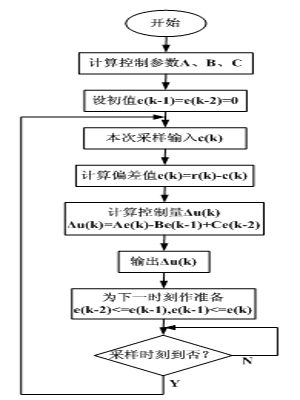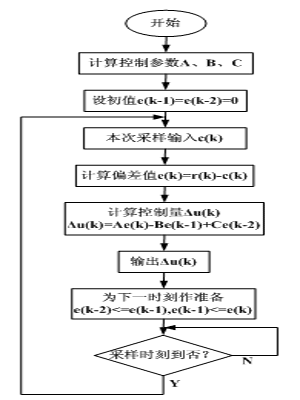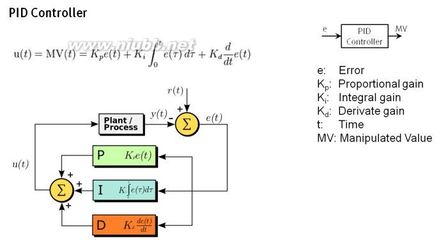#include <stdio.h>
#include<math.h>
struct _pid
{
int pv; //integer that contains the process value 过程量
int sp; //*integer that contains the setpoint 设定值
float integral; // 积分值 -- 偏差累计值
float pgain;
float igain;
float dgain;
int deadband;//死区
int last_error;
};
struct _pid warm,*pid;
int process_point, set_point,dead_band;
float p_gain, i_gain, d_gain, integral_val,new_integ;;
//----------------------------------------------
pid_init DESCRIPTION This function initializes the pointers in the_pid structure to the process variableand the setpoint. *pv and *sp are integer pointers.
//----------------------------------------------
void pid_init(struct _pid *warm, int process_point, intset_point)
{
struct _pid *pid;
pid = warm;
pid->pv = process_point;
pid->sp = set_point;
}
//----------------------------------------------pid_tuneDESCRIPTION Sets the proportional gain (p_gain), integral gain(i_gain),
derivitive gain (d_gain), and the dead band (dead_band) of a pidcontrol structure _pid.
设定PID参数 ---- P,I,D,死区
//----------------------------------------------
void pid_tune(struct _pid *pid, float p_gain, float i_gain,float d_gain, int dead_band)
{
pid->pgain = p_gain;
pid->igain = i_gain;
pid->dgain = d_gain;
pid->deadband = dead_band;
pid->integral= integral_val;
pid->last_error=0;
}
//----------------------------------------------
pid_setinteg DESCRIPTION Set a new value for the integral term ofthe pid equation.
This is useful for setting the initial outputof the pid controller at start up.
设定输出初始值
//----------------------------------------------
void pid_setinteg(struct _pid *pid,float new_integ)
{
pid->integral = new_integ;
pid->last_error = 0;
}
//----------------------------------------------
pid_bumpless DESCRIPTION Bumpless transfer algorithim.
When suddenly changing setpoints, or when restarting the PIDequation after an extended pause,
the derivative of the equation can cause a bump in the controlleroutput. This function will help smooth out that bump.
The process value in *pv should be theupdated just before this function is used.
pid_bumpless 实现无扰切换
当突然改变设定值时,或重新启动后,将引起扰动输出。这个函数将能实现平顺扰动,在调用该函数之前需要先更新PV值
//----------------------------------------------
void pid_bumpless(struct _pid *pid)
{
pid->last_error =(pid->sp)-(pid->pv);//设定值与反馈值偏差
}
//----------------------------------------------
pid_calc DESCRIPTION Performs PIDcalculations for the _pid structure *a.
This function uses the positional form of the pid equation, andincorporates an integral windup prevention algorithim.
Rectangular integration is used, so this function must be repeatedon a consistent time basis for accurate control.
RETURN VALUE The new output value for the pidloop. USAGE #include "control.h"
本函数使用位置式PID计算方式,并且采取了积分饱和限制运算
PID计算
//----------------------------------------------
float pid_calc(struct _pid *pid)
{
int err;
float pterm, dterm, result, ferror;
// 计算偏差
err = (pid->sp) - (pid->pv);
// 判断是否大于死区
if (abs(err) > pid->deadband)
{
ferror = (float) err; //dointeger to float conversion only once 数据类型转换
// 比例项
pterm = pid->pgain * ferror;
if (pterm > 100 || pterm <-100)
{
pid->integral = 0.0;
}
else
{
// 积分项
pid->integral += pid->igain *ferror;
// 输出为0--100%
// 如果计算结果大于100,则等于100
if (pid->integral > 100.0)
{
pid->integral = 100.0;
}
// 如果计算结果小于0.0,则等于0
else if (pid->integral < 0.0)
pid->integral = 0.0;
}
// 微分项
dterm = ((float)(err - pid->last_error)) *pid->dgain;
result = pterm + pid->integral+ dterm;
}
else
result =pid->integral; // 在死区范围内,保持现有输出
// 保存上次偏差
pid->last_error = err;
// 输出PID值(0-100)
return (result);
}
//----------------------------------------------
void main(void)
{
float display_value;
int count=0;
pid = &warm;
// printf("Enter the values of Process point, Set point, P gain, Igain, D gain n");
// scanf("%d%d%f%f%f", &process_point,&set_point, &p_gain,&i_gain, &d_gain);
// 初始化参数
process_point = 30;
set_point = 40;
p_gain = (float)(5.2);
i_gain = (float)(0.77);
d_gain = (float)(0.18);
dead_band = 2;
integral_val =(float)(0.01);
printf("The values of Process point, Set point, P gain, I gain, Dgain n");
printf(" %6d %6d %4f %4f %4fn", process_point, set_point, p_gain,i_gain, d_gain);
printf("Enter the values of Process pointn");
while(count<=20)
{
scanf("%d",&process_point);
// 设定PV,SP值
pid_init(&warm, process_point, set_point);
// 初始化PID参数值
pid_tune(&warm,p_gain,i_gain,d_gain,dead_band);
// 初始化PID输出值
pid_setinteg(&warm,0.0);
//pid_setinteg(&warm,30.0);
//Get input value for processpoint
pid_bumpless(&warm);
// how to display output
display_value =pid_calc(&warm);
printf("%fn", display_value);
//printf("n%f%f%f%f",warm.pv,warm.sp,warm.igain,warm.dgain);
count++;
}
}
 爱华网
爱华网


